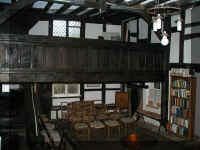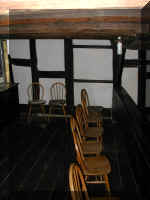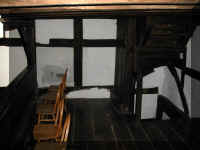| The oldest parts of the building are
thought to date back to at least 1580. Looking
at the front elevation, these parts are from the right
hand end, (i.e., the Meeting House end -
1), to the library nook in the sitting room of the
adjoining house, which was the kitchen of the original
Tudor farmhouse.
|
| The first record of the 'old house' at
Shipley is in 1682, when it is recorded: |
| " . . . the house of John
Shawes in Shipley where was held a Monthly
Men's Meeting of the Friends, where were
present William Penn, Tho. Killington, Edw.
Booker, Rich. Shawe, Jo. Shawe, John Snasholds
and others . . . "
|
|
| It would appear from the known records
that in 1691, following the Toleration Act of 1688,
many Friends in the Horsham district decided to band
together and to settle on a suitable place for worship
for the holding of a Meeting. They chose John
Shawe's house, where they had been worshipping
previously, and accepted his offer to create a Meeting
House within the farmhouse wherein he lived.
|
|

|
|
3 |
| The timbers of the first floor were
removed from the two large store-rooms at the south
end of the farmhouse in order to make room for a
suitable height for the Meeting House (3), and
at the same time leaving a gallery which was reached
by the small and narrow flight of stairs which then
continued to second floor level. The cost of
this was £53.
|
|

|
|
4
|
|

|
|
5
|
| Friends were numerous in this district
in the late 17th Century, and William Penn lived for
fifteen years at Warminghurst, only four miles
distant, and was a regular worshipper in this Meeting
House, together with his wife Gulielma. He used
to ride over with his wife and children in a coach
drawn by a team of oxen. He often used to preach
from the small Minister's gallery (not shown).
The Meeting survived only for the period between
1691 and 1793 when it was closed. the reason for
this was that the number of Quakers in the area was
seriously depleted when some 60 families emigrated
from this part of Sussex with William Penn in 1682,
and by 1786 membership of the Meeting had dropped to
10.
The Meeting was closed during the period from 1793
to 1869, when the meeting House was reopened.
Since that time there has been no break in the weekly
holding of a Meeting for Worship.
|
| The name 'Blue Idol' remains a mystery,
but possibly refers to the time when the house was
indeed colour-washed blue, and was an 'idle Meeting
House', in the sense that it was unoccupied or silent,
a term often used for a factory or building which was
unoccupied. |
|
